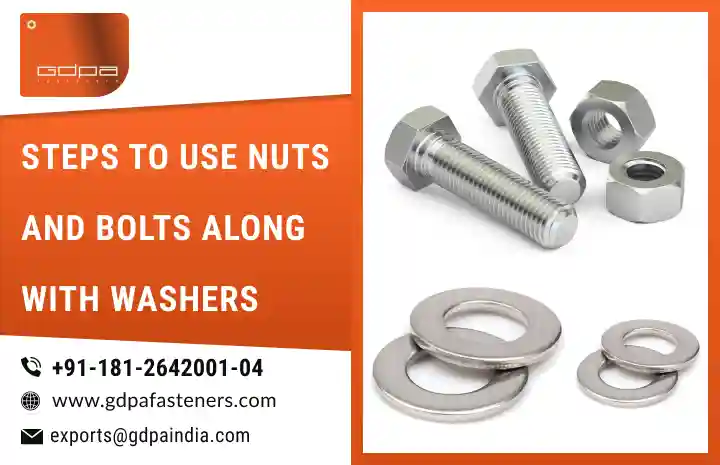
In today’s blog, we’ll discuss the steps that need to be followed to use nuts and bolts (Schrauben und Muttern). Generally, bolts fall in the category of threaded fasteners and come with a threaded nut. These two materials are used to join two or more substances together. It is generally a simple task, but sometimes it can be complicated because of different aspects such as what equipment needs the bolts and nuts (Schrauben und Muttern). Another important thing that needs to keep in mind is how the bolts are inserted into a substance or object and the type of nut required to hold it.
Guidelines for the Use of Nuts and Bolts (Richtlinien für die Verwendung von Schrauben und Muttern)
The following are some key points that a person must keep in mind while working with nuts and bolts tools (Werkzeuge für Schrauben und Muttern):
- Before trying to insert the bolt into any hole, make sure to clear the hole to remove anything that may be in it. Also, ensure that both hole and bolt are clean.
- After that, cross-check that the hole size and bolt size match each other. Because maybe the hole size is not suitable for that particular bolt.
- Once everything is sorted and cleared, insert the bolt into the hole.
- Unfortunately, if it gets stuck or doesn’t fit into the hole after a few twists, then it is a sign that you are using the wrong bolt. At this moment, don’t try to keep inserting or pushing the bolt into the hole because it can damage the thread on both the bolt and the hole.
- Ensure that your bolt fits comfortably if it is not a threaded bolt but secure it in the hole. Your bolt must easily go through the hole.
Securely Using the Bolt (Sicher mit dem Bolzen)
If the bolt size is big and the hole is small, then avoid using it. And, it is long enough, and then it may stick out to the other side of the hole but it should work. The extra part of the bolt is used to tighten the nut to hold the two objects together. You can use a wrench to twist the bolt.
Using the Nut to Secure the Bolt (Verwenden der Mutter zum Sichern der Schraube)
Take the nut that matches the size of the bolt and insert it on the opposite side of the bolt. Then hold the head of the bolt so it doesn’t move from its position and hold it securely while spinning the nut in a clockwise direction and gently press down on it. Keep twisting and applying pressure until the bolt and nut hold the two objects together. If you find it difficult to grab the bolt while twisting the nut on, then try grabbing the head of the bolt with the help of a wrench so that it doesn’t move from its place.
Why is it necessary to use a washer with bolts and nuts? (Warum ist es notwendig, eine Unterlegscheibe mit Schrauben und Muttern zu verwenden?)
You need to use a washer with nuts and bolts for the same reason you use it with screws. Technically, you don’t need to use washers for these tools, but it is suggested to use them. Basically, washers can evenly divide the load of nuts and prevent the surface from damage when you are fastening these tools together. In some cases, you may need to insert the washer on the side of the bolt, but if the bolt needs to be turned.
How to select the right nut for the bolt? (Wie wähle ich die richtige Mutter für die Schraube aus?)
With the help of threads of nuts and bolts tools (Werkzeuge für Schrauben und Muttern), they can be fastened together. One thing that needs to be considered is that both tools must be made of the same alloys. In addition to this, your nut must match or exceed the highest tensile strength of the bolt. To consider safety, then it is necessary that your nut must be stronger than your bolt. Generally, manufacturer of nuts and bolts (Hersteller von Schrauben und Muttern) makes these tools by using different material to provide the best quality to the customers.
Assembling Washers, Nuts, and Bolts (Montage von Unterlegscheiben, Muttern und Schrauben)
The following are some simple steps to assemble these three tools together:
- Check the accurate size and type of nut, bolt, and washer along with the material being used.
- On the shaft of the bolt, place the washer.
- Align the holes for the connection you are joining and push the bolt’s shaft through them. Press the washers between the bolt’s head and the material of the connection.
- Now, you can use the second washer, on the shaft’s portion of the bolt that is joining out from the joint.
- After that, you can thread the nut onto the bolt’s shaft by spinning clockwise. Fasten the nut with your hand or wrench.
Wrapping Up
The blog shares information on how to use a set of nuts, washers, and bolts together. Apart from this, if you are concerned with what type of bolts or nuts you must use, then you can search for the term ‘types of nuts and bolts with pictures’(‘Arten von Schrauben und Muttern mit Bildern’) to get an idea about the type of these tools.